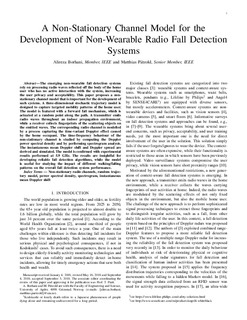| dc.contributor.author | Borhani, Alireza | |
| dc.contributor.author | Pätzold, Matthias Uwe | |
| dc.date.accessioned | 2019-04-23T07:50:58Z | |
| dc.date.available | 2019-04-23T07:50:58Z | |
| dc.date.created | 2018-09-27T16:30:40Z | |
| dc.date.issued | 2018 | |
| dc.identifier.citation | IEEE Transactions on Wireless Communications. 2018, 17 (11), 7718-7730. | nb_NO |
| dc.identifier.issn | 1536-1276 | |
| dc.identifier.uri | http://hdl.handle.net/11250/2594966 | |
| dc.description.abstract | The emerging non-wearable fall detection systems rely on processing radio waves reflected off the body of the home user who has no active interaction with the system, increasing the user privacy and acceptability. This paper proposes a nonstationary channel model that is important for the development of such systems. A three-dimensional stochastic trajectory model is designed to capture targeted mobility patterns of the home user. The model is featured with a forward fall mechanism, which is actuated at a random point along the path. A transmitter emits radio waves throughout an indoor propagation environment, while a receiver collects fingerprints of the scattering objects on the emitted waves. The corresponding radio channel is modelled by a process capturing the time-variant Doppler effect caused by the home occupant. The time-frequency behaviour of the non-stationary channel is studied by computing the Doppler power spectral density and by performing spectrogram analysis. The instantaneous mean Doppler shift and Doppler spread are derived and simulated. The model is confirmed with experimental results performed at 5.9 GHz. The results are insightful for developing reliable fall detection algorithms, while the model is useful for studying the impact of different walking/falling patterns on the overall fall detection system performance. | nb_NO |
| dc.description.abstract | A Non-Stationary Channel Model for the Development of Non-Wearable Radio Fall Detection Systems | nb_NO |
| dc.language.iso | eng | nb_NO |
| dc.title | A Non-Stationary Channel Model for the Development of Non-Wearable Radio Fall Detection Systems | nb_NO |
| dc.type | Journal article | nb_NO |
| dc.type | Peer reviewed | nb_NO |
| dc.description.version | acceptedVersion | nb_NO |
| dc.source.pagenumber | 7718-7730 | nb_NO |
| dc.source.volume | 17 | nb_NO |
| dc.source.journal | IEEE Transactions on Wireless Communications | nb_NO |
| dc.source.issue | 11 | nb_NO |
| dc.identifier.doi | 10.1109/TWC.2018.2869782 | |
| dc.identifier.cristin | 1615260 | |
| dc.relation.project | Norges forskningsråd: 261895 | nb_NO |
| dc.description.localcode | Nivå2 | nb_NO |
| cristin.unitcode | 201,15,4,0 | |
| cristin.unitname | Institutt for informasjons- og kommunikasjonsteknologi | |
| cristin.ispublished | true | |
| cristin.fulltext | postprint | |
| cristin.qualitycode | 2 | |
